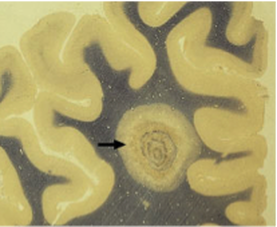 Balo's disease is a subtype of Multiple Sclerosis. Like MS, Balo's disease consists of myelin damage in the nervous system. As you might remember from my MS post, myelin is made up of fatty substances that envelope and protect nerve fibers in the spinal cord and brain. Myelin is essential for correct neurological functioning. What makes Balo's disease somewhat different from MS is that damage to the myelin is circular-shaped. Who is at risk for Balo's Disease? As with MS, Balo's disease is considered an autoimmune disorder. With Balo's disease, not only does the immune system attack healthy tissue, it also attacks healthy cells as well. While a lot is still unknown about Balo's disease, researchers do know that the following increase your risk for Balo's disease:
Symptoms of Balo's Disease
In very rare cases, Balo's disease may not show any symptoms. Diagnosis of Balo's Disease If you show signs of Balo's disease, your doctor will order an MRI of the brain and spinal cord. He or she will be looking for circular rings on damaged myelin. Damage is often in a pattern, alternating between undamaged myelin and damaged myelin. Your doctor may order more tests to further evaluate you. These tests include:
Treatment for Balo's Disease Once diagnosed, your doctor will begin treating you. There are two ways to treat Balo's Disease:
Closing Remarks There is no cure for Balo's Disease, and it can be an unpredictable disease to treat and to provide a prognosis. While medication and therapy can help with the symptoms, it cannot stop the progression of the disease. The good news is people can survive this disease, and enter remission. It is important for those with Balo's Disease to work alongside their doctors and to adhere to the treatment plan that both of you have agreed upon.
0 Comments
Your comment will be posted after it is approved.
Leave a Reply. |
Archives
|
©2017-2024


 RSS Feed
RSS Feed
